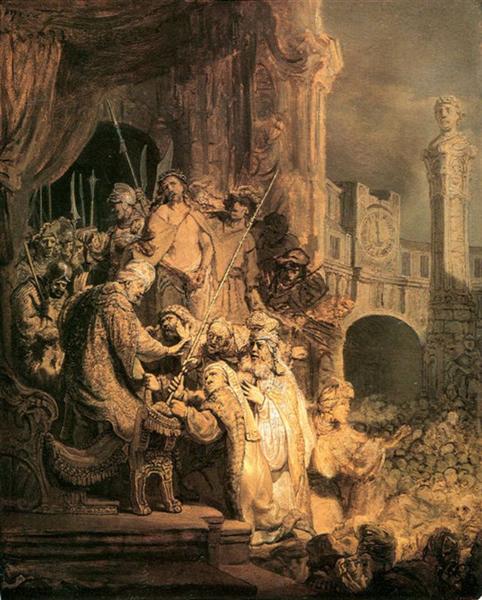Description
Rembrandt's Ecce Homo, painted in 1634, is an extraordinary testament to the Dutch master's artistic mastery and emotional depth. Depicting a key moment in the Gospel narrative, this painting invites viewers to a profound contemplation of the suffering and humanity of Jesus Christ, reflecting not only Rembrandt's technical talent but also his ability to capture the psychological complexity of the human being.
In the foreground, we find a central figure who exudes both vulnerability and dignity. The depiction of Christ is monumental, with an illuminated face that contrasts markedly with the dark background surrounding him. This use of chiaroscuro—a technique Rembrandt perfected—not only serves to guide the viewer’s gaze, drawing their attention to Jesus’ facial expression, but also creates an atmosphere charged with emotional tension. The subtle nuances of light and shadow on Christ’s skin emphasize his suffering, manifesting the physical marks of punishment and the spiritual burden he carries.
Rembrandt's colour palette is equally remarkable. Earthy tones and deep greys predominate, balanced by warm hues that bring Jesus' face to life. These colours not only delineate the character's mood, but also evoke an atmosphere of melancholy and resignation. The choice of colours is intentional, leading the viewer to reflect on sacrifice and redemption.
To the right of the composition, two supporting figures appear to be witnesses to this momentous moment. They are distinguished by their gestures and postures, which lend a sense of movement and narrative to the scene. Their faces, though less defined than Christ's, reveal a mixture of wonder and pain at the experience unfolding before them. This inclusion of supporting figures is an example of Rembrandt's humanistic approach, which seeks in all characters an emotional connection with the viewer.
The dark-hued background also plays a crucial role in the composition. Its simplicity allows the focus to be on the figure of Christ, while adding a layer of drama to the scene. This austere style is characteristic of Rembrandt's work, which places great emphasis on internal expression and emotional interaction, moving away from the decorative excess present in some contemporary works.
The work is a clear exponent of the Baroque style, where theatricality and drama play central roles. However, in "Ecce Homo", Rembrandt distances himself from the large-scale epicness associated with other Baroque masters, opting instead for a more intimate and personal approach. This is a distinctive feature of his work compared to other contemporaries, such as Rubens, who often focused on monumental grandeur.
However, "Ecce Homo" also sits within a broader context in Rembrandt's output, where the exploration of the human figure and the depiction of emotion are constant. Other works, such as "The Night Watch," although more dynamic and group-based, reflect the artist's mastery in depicting the human experience in its purest form.
In short, Rembrandt's "Ecce Homo" is a work that combines masterful technique and a profound reflection on the human condition. In its composition, play of light and shadow, and representation of the characters, we find the essence of one of the most prominent figures in the history of art. Through this painting, Rembrandt not only invites contemplation on divine justice and redemption, but also makes us part of the inner experience of his characters, forever capturing the dilemma and hope of human existence.
KUADROS ©, a famous painting on your wall.
Hand-made oil painting reproductions, with the quality of professional artists and the distinctive seal of KUADROS ©.
Painting reproduction service with satisfaction guarantee. If you are not completely satisfied with the replica of your painting, we will refund 100% of your money.

